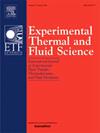Experimental investigation of chocked cavitation flow and its oscillation mechanism in jet pump cavitation reactors under limited operation stage
IF 2.8
2区 工程技术
Q2 ENGINEERING, MECHANICAL
Experimental Thermal and Fluid Science
Pub Date : 2024-10-16
DOI:10.1016/j.expthermflusci.2024.111332
引用次数: 0
Abstract
Experiments were conducted in this study to investigate the chocked cavitation characteristics and its oscillation mechanism in jet pump cavitation reactors (JPCR) under limited operation stage (LOS) utilizing a synchronous measurement system. The pulsation characteristics of cavitation in JPCR under various inlet and outlet pressures were analyzed by the processed high-speed camera images. Furthermore, correlation between cavitation and pressure pulsation as well as the mechanism of cavitation oscillation in JPCR under LOS are elucidated based on synchronized measurements. The results reveal that the typical jet choked cavitation flow field can be divided into three characteristic regions, i.e., stability region, oscillation region and collapse region. Changes in flow parameters cause variations in the areas of these three regions and shift the initial and collapse positions of cavitation. The time-averaged length of cavitation clouds varies linearly with the absolute pressure ratio at the outlet, corresponding to both stable and unstable LOS. Notably, the results reveal a clear correlation between the grayscale of cavitation clouds and pressure fluctuations over time, identifying the inverse pressure gradient as the primary cause of cavitation oscillation in the throat tube during unstable LOS.
有限运行阶段喷射泵空化反应器中阻塞空化流及其振荡机制的实验研究
本研究利用同步测量系统,对喷射泵空化反应器(JPCR)在有限运行阶段(LOS)下的阻塞空化特性及其振荡机制进行了实验研究。通过处理后的高速摄像图像,分析了喷射泵空化反应器在不同入口和出口压力下的空化脉动特征。此外,基于同步测量还阐明了气蚀与压力脉动之间的相关性以及 LOS 条件下 JPCR 中气蚀振荡的机理。研究结果表明,典型的喷气窒息空化流场可分为三个特征区域,即稳定区、振荡区和崩溃区。流动参数的变化会导致这三个区域的面积发生变化,并移动空化的初始位置和塌陷位置。空化云的时间平均长度与出口处的绝对压力比呈线性变化,与稳定和不稳定 LOS 相对应。值得注意的是,结果显示空化云的灰度与压力随时间的波动之间存在明显的相关性,从而确定反向压力梯度是不稳定 LOS 期间喉管内空化振荡的主要原因。
本文章由计算机程序翻译,如有差异,请以英文原文为准。
求助全文
约1分钟内获得全文
求助全文
来源期刊

Experimental Thermal and Fluid Science
工程技术-工程:机械
CiteScore
6.70
自引率
3.10%
发文量
159
审稿时长
34 days
期刊介绍:
Experimental Thermal and Fluid Science provides a forum for research emphasizing experimental work that enhances fundamental understanding of heat transfer, thermodynamics, and fluid mechanics. In addition to the principal areas of research, the journal covers research results in related fields, including combined heat and mass transfer, flows with phase transition, micro- and nano-scale systems, multiphase flow, combustion, radiative transfer, porous media, cryogenics, turbulence, and novel experimental techniques.
 求助内容:
求助内容: 应助结果提醒方式:
应助结果提醒方式:


